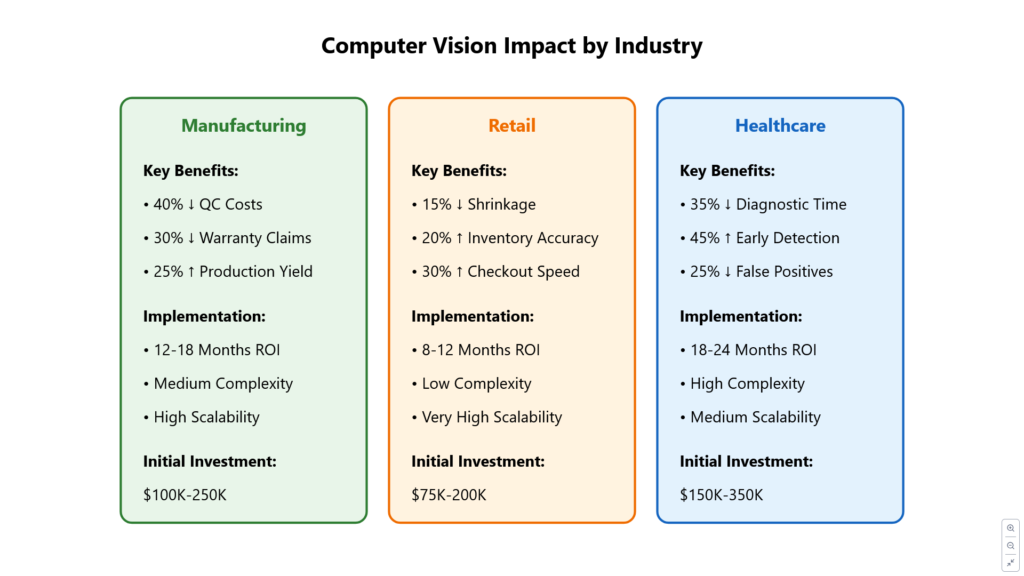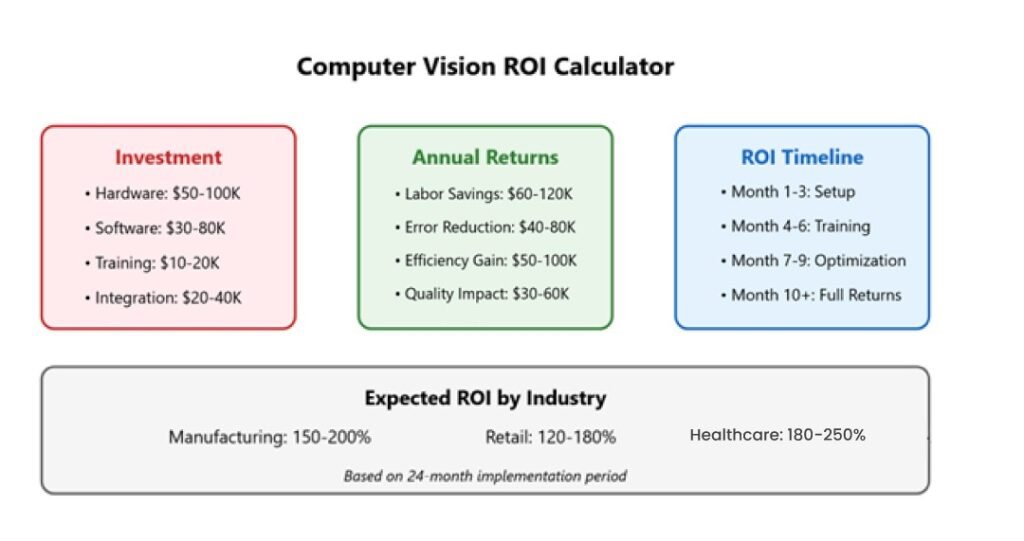In today’s data-driven business landscape, computer vision technology has moved beyond experimental projects to become a crucial driver of business value. But how do you justify the investment in AI-powered visual intelligence? Let’s dive into the concrete returns that businesses can expect when implementing computer vision solutions.
Understanding the Investment Components
Initial Costs
⦁ Hardware Infrastructure
⦁ Cameras and sensor equipment
⦁ Computing resources (edge devices or cloud infrastructure)
⦁ Network infrastructure upgrades
⦁ Software Development
⦁ Custom algorithm development
⦁ Integration with existing systems
⦁ Testing and deployment
⦁ Human Resources
⦁ Training for existing staff
⦁ New specialized personnel
⦁ Ongoing maintenance support
Measuring Direct Returns
Measuring direct returns from implementing advanced visual inspection technologies and automated systems is crucial for understanding their impact on operational efficiency, quality improvements, and labor cost optimization.
Operational Efficiency
⦁ Reduction in manual inspection time by 70-90%
⦁ Decreased error rates by up to 90%
⦁ 24/7 operational capability without fatigue
⦁ Increased throughput in visual inspection processes
Quality Improvements
⦁ Early detection of defects reducing waste
⦁ Consistent quality standards
⦁ Reduced customer returns and complaints
⦁ Enhanced brand reputation
Labor Cost Optimization
⦁ Reduction in routine visual inspection tasks
⦁ Reallocation of human resources to higher-value activities
⦁ Lower training costs for routine tasks
⦁ Reduced human error-related expenses
Hidden Value Drivers
In addition to direct returns, automated systems provide hidden value drivers that enhance overall business performance and competitiveness.
Risk Mitigation
⦁ Improved compliance documentation
⦁ Reduced liability exposure
⦁ Better safety monitoring
⦁ Enhanced security measures
Competitive Advantage
⦁ Faster time-to-market
⦁ Improved product quality
⦁ Enhanced customer satisfaction
⦁ Data-driven decision making capabilities
⦁ Easy replication across locations
⦁ Consistent performance standards
⦁ Reduced scaling costs
⦁ Flexible capacity adjustment
Industry-Specific ROI Examples
The return on investment (ROI) from automated systems varies across different industries, with significant financial benefits and efficiency gains.
Manufacturing
⦁ 40% reduction in quality control costs
⦁ 30% decrease in warranty claims
⦁ 25% improvement in production yield
⦁ ROI typically achieved within 12-18 months
Retail
⦁ 15% reduction in shrinkage
⦁ 20% improvement in inventory accuracy
⦁ 30% increase in self-checkout efficiency
⦁ ROI typically achieved within 8-12 months
Healthcare
⦁ 35% reduction in diagnostic time
⦁ 45% improvement in early detection rates
⦁ 25% decrease in false positives
⦁ ROI typically achieved within 18-24 months
By understanding and measuring these direct returns and hidden value drivers, businesses can make informed decisions about investing in automated systems, ensuring both immediate financial benefits and long-term strategic advantages.

Figure 1: Industry ROI Comparison Detailed comparison of computer vision implementation across manufacturing, retail, and healthcare sectors, including key benefits, implementation details, and investment requirements.
Calculating Your ROI
To calculate the return on investment (ROI) for an AI-powered medical imaging system, a structured, step-by-step approach is crucial. This ensures that you not only estimate potential returns but also identify and mitigate any challenges along the way. Here’s a breakdown of the process:
Step-by-Step Approach
⦁ Baseline Assessment
⦁ Document current costs: Start by identifying and documenting all the costs associated with your current processes, such as labor costs, equipment, and downtime.
⦁ Measure existing performance metrics: Establish a benchmark for key metrics like diagnostic time, accuracy, and resource usage.
⦁ Identify pain points and inefficiencies: Look for areas where the current system is falling short, such as high error rates or long turnaround times.
⦁ Implementation Costs
⦁ Hardware and software investments: Calculate the initial and ongoing costs for the technology, including any required hardware and software.
⦁ Integration expenses: Consider the cost of integrating the new system with existing platforms, such as PACS or EHR.
⦁ Training and support costs: Factor in the expenses associated with training staff and providing ongoing technical support.
⦁ Projected Returns
⦁ Direct cost savings: Estimate savings from reduced labor costs, fewer repeat exams, and optimized resource utilization.
⦁ Efficiency improvements: Calculate gains from faster diagnostics, reduced errors, and better resource allocation.
⦁ Quality enhancements: Consider the improvements in diagnostic accuracy and early detection that result in better patient outcomes.
⦁ Risk reduction values: Include potential savings from fewer misdiagnoses, reduced liability, and improved compliance.
⦁ Timeline Analysis
⦁ Implementation period: Estimate how long it will take to deploy the system and begin seeing initial results.
⦁ Ramp-up phase: Allow time for system calibration, staff adaptation, and fine-tuning, which will impact the full benefits realized.
⦁ Full deployment benefits: Identify when you can expect to see the system’s full potential realized in terms of efficiency, accuracy, and ROI.

Figure 2: Computer Vision ROI Calculator Framework A comprehensive breakdown of investment costs, expected returns, and typical implementation timeline for computer vision projects.
Risk Factors to Consider
When implementing AI-powered solutions in medical imaging, it’s crucial to be aware of the potential risks and how to mitigate them. Here are some key risk factors to consider:
Technical Risks
⦁ Integration challenges
⦁ Performance variations
⦁ System reliability
⦁ Upgrade requirements
Operational Risks
⦁ Staff adoption
⦁ Process changes
⦁ Maintenance needs
⦁ Data management
Market Risks
⦁ Technology evolution
⦁ Competitive pressure
⦁ Regulatory changes
⦁ Customer acceptance
Best Practices for Maximum ROI
To ensure the highest return on investment, following these best practices can make a significant difference:
1. Start Small
⦁ Begin with pilot projects
⦁ Focus on high-impact areas
⦁ Validate assumptions
⦁ Scale based on results
2. Measure Everything
⦁ Establish clear KPIs
⦁ Track all relevant metrics
⦁ Document improvements
⦁ Analyze trends
dapibus leo.
3. Engage Stakeholders
⦁ Get buy-in from all levels
⦁ Provide adequate training
⦁ Communicate benefits clearly
⦁ Address concerns proactively
Making the Business Case
When presenting the business case for AI-powered medical imaging, ensure that it is comprehensive and well-supported. Include the following essential elements and supporting data:
Essential Elements
⦁ Clear problem definition
⦁ Detailed cost analysis
⦁ Expected benefits
⦁ Implementation timeline
⦁ Risk mitigation strategies
⦁ Success metrics
Supporting Data
⦁ Industry case studies
⦁ Pilot project results
⦁ Competitor analysis
⦁ Market trends
Conclusion
Investing in computer vision technology is no longer just about staying current with technology trends – it’s about achieving measurable business results. While the initial investment may seem significant, the ROI potential through improved efficiency, quality, and competitive advantage makes it a compelling business case for most organizations.

